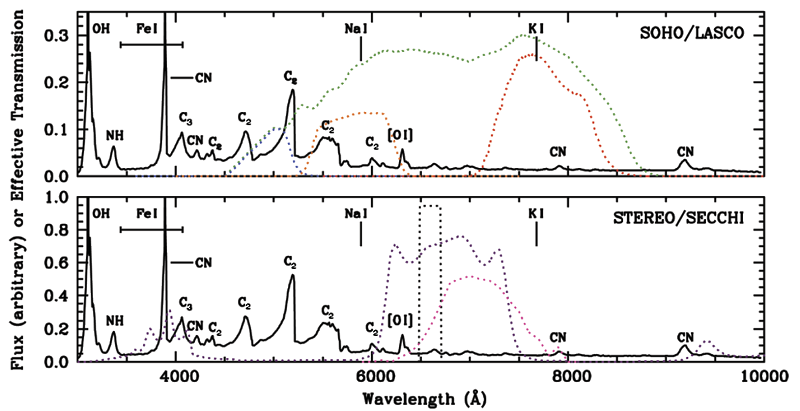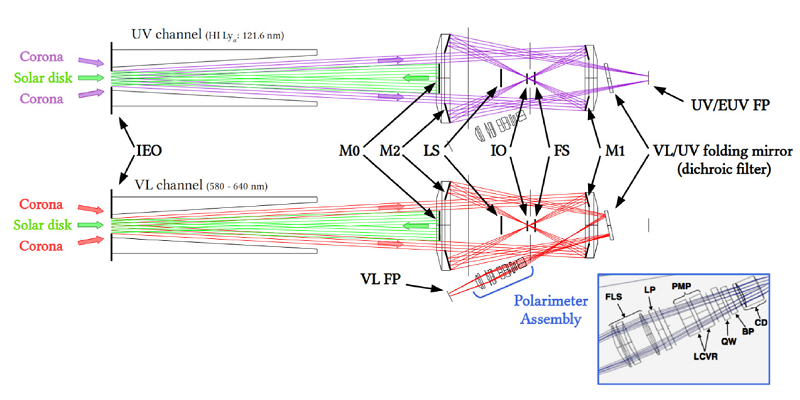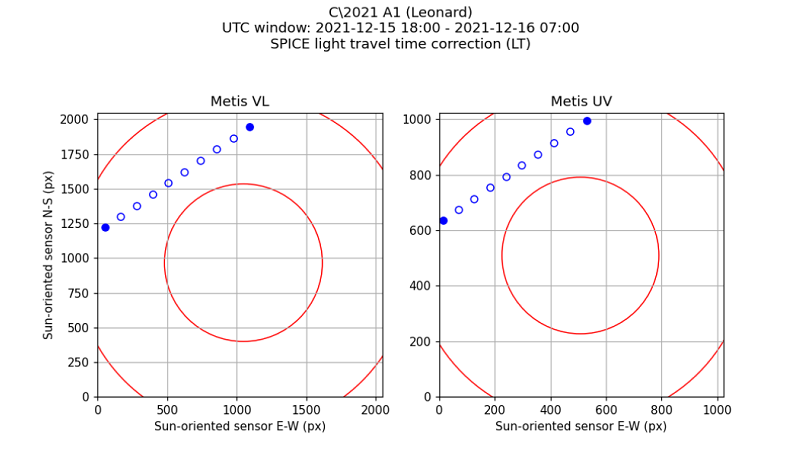- 1CNR-IFN Padova, Padova, Italy (vania.dadeppo@pd.ifn.cnr.it)
- 2University of Calabria, Cosenza, Italy
- 3INAF-OATo, Torino, Italy
- 4US Naval Research Laboratory, Washington DC, USA
- 5CISAS, University of Padova, Padova, Italy
- *A full list of authors appears at the end of the abstract
Abstract
The Metis coronagraph on-board the Solar Orbiter ESA mission is devoted to the study of the solar corona, but will also have the chance to observe near-Sun comets. Starting from November 2021 the scientific phase of the Solar Orbiter mission will take place.
Metis can observe comets passing into its Field of View (FoV) covering an annulus between 1.6° and about 3° centered in the Sun direction.
For the first time, simultaneous observation of comets both in the visible and in the UV at the Lyman-alpha can be performed.
Comets with known trajectories passing in the Metis FoV will be planned to be observed; all the other comets, likely to be the majority, will be observed by serendipity.
1. Introduction
A comet passing through the solar corona provides a means to estimate the plasma parameters at each point along its path, which is a useful complement to remote sensing.
In addition to the clear value for solar physics, heliophysics, and space weather application, continuous coverage of the region surrounding the Sun by a coronagraph is important for the advancement of our understanding of near-Sun comets [1].
SOHO-LASCO C2 and C3 have discovered about 4 thousand Sun-grazing and near-Sun comets; STEREO-SECCHI has also discovered a number of comets.
SOHO-UVCS had the chance to study about 20 comets in the UV [2].

Figure 1 SOHO-LASCO and STEREO-SECCHI bandpasses overlaid on a typical comet spectrum expressed in arbitrary units [1].
As for the future solar missions, Solar Orbiter has been launched in February 2020 and, after a commissioning phase, its nominal scientific mission will start in November 2021. The mission is foreseen to last for about 10 years with the spacecraft orbit slowly moving out of the ecliptic plane to allow the study of the Sun’s polar regions.
On board the Solar Orbiter spacecraft the Metis coronagraph is mounted [3].
2. The Metis coronagraph
Metis has been conceived to acquire both visible and UV images of the solar corona. It is the first coronagraph that will allow simultaneous observation in visible light (VL) and UV.
The Metis instrument is conceived to image the solar corona from a near-Sun orbit in the UV narrow band HI Lyman-alpha at 121.6 nm, and in the polarized broad-band visible light (580 – 640 nm).
The instrument is designed to image the structure and dynamics of the full corona in the range from 1.6 to 3.1 solar radii (Rs), at minimum perihelion distance (0.28 AU), and from 2.8 Rs to 5.5 Rs, at 0.5 AU. The annular FoV covered by the instrument is between 1.6° and 2.9°, and the attained spatial resolution is 20" [4].
A sketch of the raytrace of the two channels of the Metis coronagraph, i.e. the UV and VL, is given in Figure 2.

Figure 2 Metis layout. On the top: the UV path. On the bottom: the VL path [4].
The VL channel bandpass of Metis includes the NaI doublet, i.e. at about 589 nm, and this feature should help comet observation since the NaI emissions may make near-Sun comets very bright. As for the UV channel, strong Lyman-alpha emissions are expected to be observed in comets [5].
The scientific highlights of Metis coronagraph observation of comets can be summarized as follows:
- VL observations near comet perihelion are useful to study scattering, side distribution, and quantity of dust.
- HI Lyman-alpha observation allows to infer solar wind direction, speed and density.
- Analyze comet tail direction and its dynamics [6].
3. Planning for observing comets
In order to predict and allow planning for the observation of known comets, a tool to calculate the “transit” of the comet in the FoV of Metis is being devised by the team.
An example of the foreseen passage of the comet C/2021 A1 Leonard in December 2021 can be seen in Figure 3.

Figure 3 Expected “transit” of the comet Leonard in the Metis FoV both for the VL and the UV channel.
4. Conclusions
The Metis coronagraph on-board the Solar Orbiter mission will have the chance to observe some comets.
Future observation campaigns are foreseen and will be devoted to study some of the possible comets passing inside the instrument FoV both in the VL, with the possibility of polarization imaging, and at the same time in the UV (Lyman-alpha).
Some other comets will be imaged by chance during the nominal observation foreseen for Metis.
Both the populations “foreseen” and ‘by chance’ comets can give some insights to probe the near environment of the Sun but also help in studying the physics and processes occurring in the tail and nucleus of the comet itself.
For the first time and of extreme importance, with the Metis coronagraph, comets are going to be observed simultaneously both in the visible and in the UV (Lyman-alpha).
Acknowledgements
Solar Orbiter is a space mission of international collaboration between ESA and NASA, operated by ESA. Metis was built and operated with funding from the Italian Space Agency (ASI), under contracts to the National Institute of Astrophysics (INAF) and industrial partners. Metis was built with hardware contributions from Germany (Bundesministerium für Wirtschaft und Energie through DLR), from the Czech Republic (PRODEX) and from ESA.
References
[1] Jones, G.H. et al., "The Science of Sungrazers, Sunskirters, and Other Near-Sun Comets", Space Sci Rev 214(20) (2018).
[2] Bemporad, A. et al., "A review of SOHO/UVCS observations of sungrazing comets", Planetary and Space Science 55(9), 1021-1030 (2007).
[3] Antonucci, E. et al., "Metis: the Solar Orbiter visible light and ultraviolet coronal imager,” A&A 642, A10 (2020).
[4] Fineschi, S. et al., "Optical design of the multi-wavelength imaging coronagraph Metis for the solar orbiter mission," Exp. Astron. 49, 239-263 (2020).
[5] Bertaux, J. L. et al. "Interpretation of Hydrogen Lyman-Alpha Observations of Comets Bennett and Encke", A&A 25, 415-430 (1973)
[6] Nisticò, G. et al., "Oscillations of cometary tails: a vortex shedding phenomenon?", A&A 615, A143 (2018).
Alessandro Bemporad, Boe Benjamin, Pamela Cambianica, Chiara Casini, Alain Jody Corso, Gabriele Cremonese, Fabio Frassetto, Shadia Habbal, Stavro Ivanovski, Geraint Jones, Matthew Knight, Philippe Lamy, Salvatore Mancuso, Antonio Martinez, Maurizio Pancrazzi, John Raymond, Cecilia Tubiana, Michela Uslenghi, Cis Verbeeck, Jean-Claude Vial, Gaetano Zimbardo, Daniele Spadaro, Marco Stangalini, Marco Romoli
How to cite: Da Deppo, V., Nisticò, G., Giordano, S., Battams, K., Gallagher, B., and Chioetto, P. and the Metis "Comets and other Solar System Bodies" Topical Team: Observing comets with the Metis coronagraph on-board the Solar Orbiter mission, Europlanet Science Congress 2021, online, 13–24 Sep 2021, EPSC2021-394, https://doi.org/10.5194/epsc2021-394, 2021.

